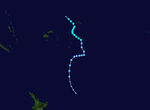1972–73 South Pacific cyclone season
| 1972–73 South Pacific cyclone season | |
|---|---|

Season summary map
|
|
| Seasonal boundaries | |
| First system formed | October 19, 1972 |
| Last system dissipated | April 6, 1973 |
| Strongest storm | |
| Name | Bebe |
| • Maximum winds | 155 km/h (100 mph) (11-minute sustained) |
| • Lowest pressure | 945 hPa (mbar) |
| Seasonal statistics | |
| Total disturbances | 8 |
| Tropical cyclones | 8 |
| Severe tropical cyclones | 2 |
| Total fatalities | Unknown |
| Total damage | Unknown |
| Related articles | |
| Category 3 severe tropical cyclone (Australian scale) | |
| Category 3 tropical cyclone (SSHWS) | |
| Duration | October 19 – October 29 |
|---|---|
| Peak intensity | 155 km/h (100 mph) (10-min) 945 hPa (mbar) |
| Category 1 tropical cyclone (Australian scale) | |
| Tropical storm (SSHWS) | |
| Duration | November 2 – November 3 |
|---|---|
| Peak intensity | 65 km/h (40 mph) (10-min) 990 hPa (mbar) |
| Category 3 severe tropical cyclone (Australian scale) | |
| Category 1 tropical cyclone (SSHWS) | |
| Duration | December 6 – December 18 |
|---|---|
| Peak intensity | 130 km/h (80 mph) (10-min) 965 hPa (mbar) |
| Category 2 tropical cyclone (Australian scale) | |
| Tropical storm (SSHWS) | |
| Duration | January 31 – February 7 |
|---|---|
| Peak intensity | 100 km/h (65 mph) (10-min) 980 hPa (mbar) |
| Category 1 tropical cyclone (Australian scale) | |
| Tropical storm (SSHWS) | |
| Duration | January 14 – January 18 |
|---|---|
| Peak intensity | 70 km/h (45 mph) (10-min) 990 hPa (mbar) |
| Category 1 tropical cyclone (Australian scale) | |
| Tropical storm (SSHWS) | |
| Duration | January 31 – February 1 |
|---|---|
| Peak intensity | 75 km/h (45 mph) (10-min) 990 hPa (mbar) |
| Category 1 tropical cyclone (Australian scale) | |
| Tropical storm (SSHWS) | |
| Duration | January 31 – February 4 |
|---|---|
| Peak intensity | 75 km/h (45 mph) (10-min) 990 hPa (mbar) |
| Category 2 tropical cyclone (Australian scale) | |
| Tropical storm (SSHWS) | |
| Duration | April 2 – April 6 |
|---|---|
| Peak intensity | 100 km/h (65 mph) (10-min) 980 hPa (mbar) |
The 1972–73 South Pacific cyclone season ran year-round from July 1 to June 30. Tropical cyclone activity in the Southern Hemisphere reaches its peak from mid-February to early March.
Tropical Cyclone Bebe was a pre-season storm that impacted the Gilbert, Ellice, and Fiji island groups. First spotted on October 20, the system intensified and grew in size through October 22. Its course began along a south-southwest trajectory before recurving near the 14th parallel south, which resulted in a south-southeast motion through the western portion of the Fiji island group. It became the first cyclone to impact Fiji since 1952. On October 24, winds of 150 knots (280 km/h) or more were reported on Rotuma and Viti Levu. Cyclone Bebe passed through Funafuti on Saturday 21st and Sunday 22 October 1972. At about 4 p.m. on the 21st, sea water was bubbling through the coral on the airfield with the water reaching a height of about 4 –5 feet high. The Ellice Islands Colony's ship Moanaraoi was in the lagoon and survived, however 3 tuna boats were wrecked. Waves broke over the atoll. Five people died, two adults and a 3 month old child were swept away by waves, and two sailors from the tuna boats were drowned. Cyclone Bebe knocked down 90% of the houses and trees. The storm surge created a wall of coral rubble along the ocean side of Funafuti and Funafala that was about ten to twelve miles long, and about ten to twenty feet thick at the bottom. The cyclone submerged Funafuti and sources of drinking water were contaminated as a result of the system's storm surge and fresh water flooding. After passing by the archipelago, Bebe transitioned into an extratropical cyclone, with the remnants last noted on October 28. A total of 28 people died and thousands were left homeless. Damages totaled $20 million (1972 USD).
Collette existed from November 2 to November 3.
Diana existed from December 6 to December 18.
Elenore existed from January 31 to February 7.
...
Wikipedia










